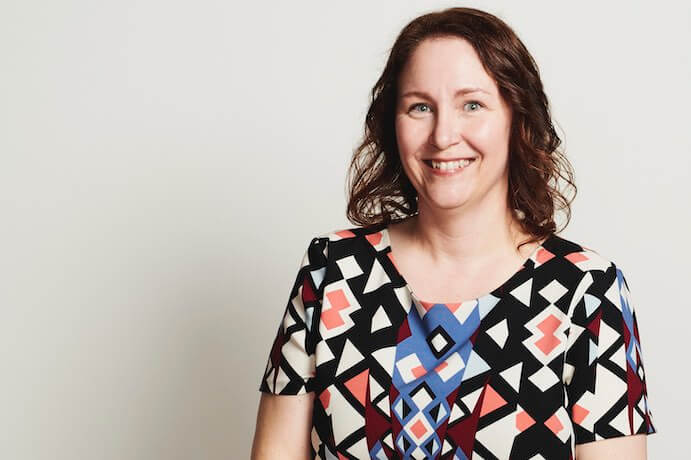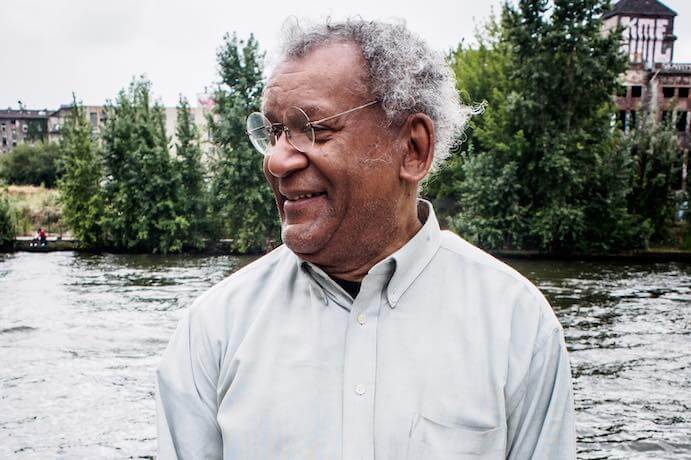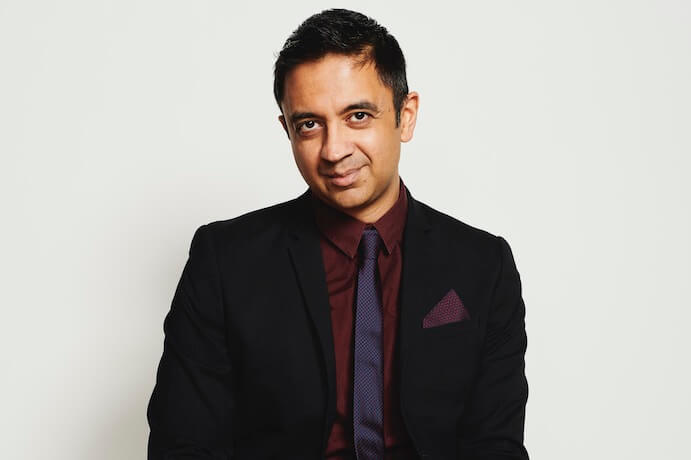Lara Pellegrinelli is a writer whose work covers contemporary classical music; her pieces range from articles for NPR parsing the facts and figures of music education in American public schools to remarkably in-depth program notes for institutions like the Miller Theater. Her recent work writing these program notes for Miller Theater’s Composer Portraits series take readers by the hand and into the composer’s workspace (Kate Soper’s study contains “[a]n Ikea desk that has admirably withstood multiple, interstate moves, barricading the single window. And its partner, a full-sized, electric keyboard, positioned at a 90° angle”) and into their psyche, helping the reader to see these artists’ work through a wide, context-enhanced lens (“[i]nstead of characterizing [Tyshawn] Sorey’s practice as one that blurs boundaries, it’s high time to acknowledge that those lines are artificial in the first place, drawn and maintained to foist identities on groups of people, while preserving the prestige of some traditions at the expense of others”). Lara teaches at The New School and Bard’s Microcollege at Brooklyn Public Library, and since you’re reading this, chances are high that you’ve already read and enjoyed her work in the past.
What was the first program note you wrote?
This may come as a surprise, but I only wrote my first program note last year for Kate Soper’s Composer Portrait at Miller Theatre. I’d done other kinds of writing that are similar to program notes—for example, thematic essays for the program guides of the old JVC Jazz Festivals and the White Light Festival, as well as interviewing artists to preview upcoming performances at Lincoln Center for Score!, their online, in-house publication. But I never sought work writing the kind of notes that you tend to see serving standard repertoire at major institutions.
I’m probably not alone in this. Program notes are what writers refer to as “work for hire;” they’re created at the behest of a client according to the client’s specifications. If you’re a musician reading this, think of the job of writing program notes as roughly the equivalent of a wedding gig: it pays the bills, but it’s not likely to scratch your creative itches. And, for the most part, that’s how it feels when you read them.
So I never imagined I’d be doing this, but, then again, I have a very different relationship to the notes I write for Miller. To start with, I have deep respect for the programming of our Executive Director Melissa Smey, and the composers whose work I am tasked with framing for an audience are undeniably significant to the contemporary musical scene. Sometimes, I’m the first person to write about the pieces on the program, which is both a hefty responsibility and thrilling. Beyond this, Melissa has given me license to be creative because it serves her audiences well. Instead of bringing the music down to the listener, which runs the danger of precluding their own intuitive, emotional responses to music, I am attempting to engage them in a world of ideas that enriches their understanding. It is a marvelous, unexpected bonus that I get to produce writing that feels like my own voice–the voice of a woman in a male-dominated field–rather than something that is formal and institutional.

Tell us about your process in writing a program note like those for Miller Theater Composer’s Portraits. They’re long and detailed, immersive and thoughtful. How long does this process take from beginning to end?
First of all, thank you! Second, frankly, I’m in denial about how long they take. As you might imagine, they are quite labor intensive, easily upwards of 40 hours each. It depends how many individual works are on a program and its stylistic range. For example, Anthony Braxton’s portrait, which will open our 2019-20 concert season, includes a total of eight works and spans 30 years of his career, requiring me to be familiar with several different musical systems of his own invention. Writing those felt like running a marathon. In contrast, David T. Little’s program last spring contained two works that were produced in reasonable proximity to each other chronologically. Writing those notes was still challenging, but there was less to grapple with in terms of the volume and breadth of material.
Ideally, I spread the labor over two or three weeks so that I have a chance to let my subconscious work. That helps immensely. I usually start by setting aside a day to do basic background research on the composer, reading bios, major press, and interviews. I listen to major works and the works on the program if they’re available, though often the commissions are still in the process of being written. Once I know who the composers are on the season, I keep an eye out for any performances of their work I can attend.
An interview with the composer is the most essential component in terms of the direction the notes will take. What they have to say about their work is certainly as important as anything I have to say. I use transcription software and listen back to an interview in its entirety at least once, pulling quotes that I feel get to the heart of our conversation and offer the greatest insights on why the composer makes the music that they do. I keep track of specific information on the individual works under headings I create for each piece. Then I start to knit it together.
I have become a big fan of drafting, which is something I’ve really only learned to do in the last five years in working with my own writing students. I try to fact check at that stage, so that no inaccuracies can slip into the final version. I like to put a rough draft away for a couple of days to make sure everything is where it needs to be and the material gels before I start to refine it. I like to have a day or two between a good draft and the final so that I can really tighten up and polish the prose. I put in a great deal of hard work in the hopes that reading the notes will be anything but that.

Can you tell us a few of the program note tropes or traps that you’ve seen along the way so that readers might attempt to avoid them the next time they’re tasked with writing program notes themselves?
I don’t have any specific pet peeves, probably because I’m of the opinion that we need to throw out this whole genre of writing about music and start from scratch. I want to be clear that I don’t think others have to write program notes the way that I do, but, whatever form they take, they need to actively engage the reader. If hearing live music offers us pleasure, or the possibility of an emotional journey, or new cultural insights, then notes should aspire to do the same as a literary form.
What I take away from reading what I would characterize as typical program notes–written under the guise of objectivity at a historical remove from their subjects–is that the classical tradition is a singularity. As texts, notes impose a kind of authority that signals there is one tradition, with a correct way to think and write about it—which we will provide for you. This is simply untrue! And I find it disrespectful of the audience’s intelligence. It is possible to inform them without telling them what or how to think. I mean, you wouldn’t prepare a sumptuous meal and then chew your guests’ food for them, would you?
The week before last, I had a wonderful conversation with Vijay Iyer about his upcoming Composer Portrait, and he brought up an exchange that he’d had with the late composer and pianist Muhal Richard Abrams. Muhal expressed the opinion that the whole purpose of music is to excite the different perspectives of those who are listening to it—that is why music exists, he said. Read: listeners are not passive vessels. Nor is music a fixed object, I will add. That which is fixed is dead.
So then how do we convey that classical music is a multiplicity? Which is especially important if we sincerely wish to embrace those who were written out of its history, meaning everyone except white men. Classical music is alive because there are people performing it, teaching it, and writing about it—all kinds of people, all over the world. If I am going to a concert of Beethoven, I appreciate having the requisite historical information on the composer, but I am far more interested in a performer’s relationship to Beethoven and his music, how they see it as relevant to their life, and to us as a society. That is the essence of a living tradition, and one that an audience rarely has access to through program notes.
All this is to say that I would encourage writers to look for ways to highlight subjectivity, whether the performers’ or their own. Because as soon as you’ve shown your audience that you are expressing one of many possible viewpoints about the music, you have given them permission to do the same and to form their own relationships with the material.

Is there a specific question or two that you always ask the artists you interview?
No, but I tend to start conversations for the Composer Portrait notes in the same way. I always ask the composer to tell me what new projects they’re working on right now. It’s a strategy that gets them talking and establishes rapport because it shows that I care about their music beyond what I was hired to do. Gathering that information has other advantages for me, and for them, if I can work it into the notes. It extends their timeline into the future for a prospective audience member that might like to hear them again. While including this information in a note may not be directly beneficial to Miller Theatre, anything we can do to connect audiences to live performances and make dedicated listeners out of them is good for the health of the scene as a whole.
What is one word of advice you would give to young artists when they write—on social media, in a school newspaper, in program notes, or for a publication—about their colleague’s work or the work of artists they admire?
Look for opportunities for exchange, real human exchange, about the music. It is the equivalent of the moments of connection you feel in performance. Attempt to represent it on the page. We need to do our best to understand each other with kindness, even when we don’t hold the same viewpoints. In fact, we should seek out diverse viewpoints. I don’t always like the music I write about in terms of my own personal tastes, but that doesn’t mean that I can’t see something relatable, interesting, or valuable in it. That is where my training as an ethnomusicologist comes in: I always attempt to see the music as its creators do, first and foremost. That provides the framework from which I can do my own critical thinking.
























